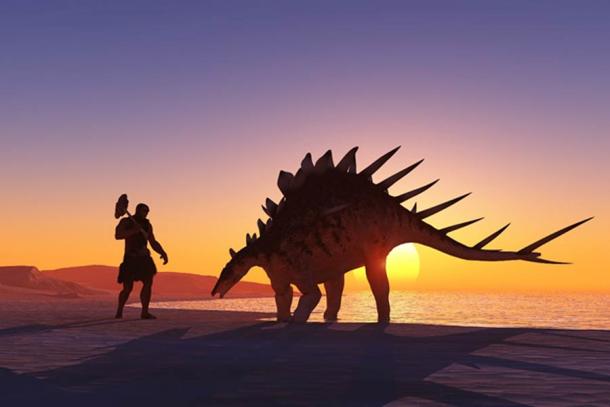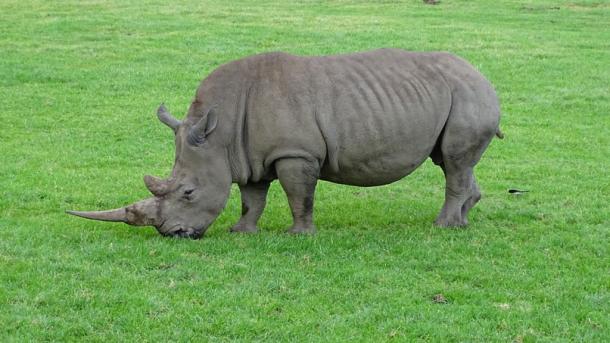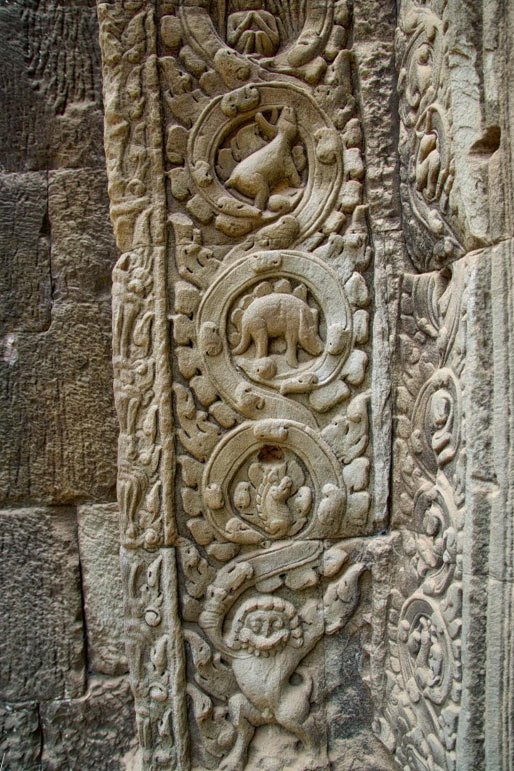Mainstream paleontologists say that dinosaurs went extinct 65 million years before the evolution of modern humans. This, however, has not stopped the suggestion that some dinosaurs may have survived as relict populations and have appeared in human artwork. An example of artwork put forward as evidence for this view is a cryptic carving at Ta Prohm, a beautifully overgrown temple in Angkor, the capital city of the former Khmer Empire.
Ta Prohm was built during the reign of the Khmer ruler, Jayavarman VII (1181-1218 AD) as a monastery for Mahayana Buddhism. After the dissolution of the Khmer Empire, the temple was abandoned and reclaimed by the forest until the 19th century, when archaeological excavations at the site of Angkor began.
Ta Prohm is most famous today for the fascinating appearance of the giant tree roots which have wound their way through the loosened stones. However, that beautiful view is being carefully watched and maintained these days to ensure that the temple will not deteriorate further or become unsafe for the countless visitors who marvel at the site each year.

The famous ‘Tomb Raider’ doorway, Ta Prohm Temple, Angkor, Cambodia. (Paul Mannix/ CC BY 2.0 )
Wait, is that a Stegosaurus?
The reason that Ta Prohm has become important for those interested in living populations of dinosaurs is a creature engraved on the walls of the temple that, to some, bears a striking resemblance to a stegosaurus. What makes this creature saurian in appearance are protrusions on its back that look like the dorsal plates of the well-known dinosaur. This is an especially popular claim among young earth creationists who believe that it represents evidence that dinosaurs lived with humans late enough that they were engraved on temple walls.
Could this creature be a dinosaur? To the modern mind, it does resemble a dinosaur. There are, however, several problems with this hypothesis. The first problem is that the alleged plates also resemble artistic flourishes that occur in many other carvings around the temple.

The Ta Prohm ‘dinosaur’. (Uwe Schwarzbach/ CC BY NC SA 2.0 )
They do look a little different from the other flourishes, but the possibility that they are flourishes cannot be ruled out. If the flourishes are removed, the creature bears less resemblance to a dinosaur and more resemblance to something like a rhinoceros.
Without the plate-like carvings above its back, there isn’t really much of a reason to suppose that this creature is a stegosaurus or any other dinosaur for that matter. For one thing, the animal lacks the prominent spikes on the back of the tail that are so characteristic of the dinosaur. Since this is a very distinctive feature of the animal, it seems unlikely that an artist would leave out that detail. Furthermore, on the back of the animal’s head are what appear to be ears or horns which the stegosaurus probably did not have. The creature’s head is also not the right shape.

Reconstruction of a stegosaurus in a forest. ( warpaintcobra /Adobe Stock)
Or Maybe it is a Spike-less Dinosaur?
Supporters of the position that the animal is a stegosaurus have suggested possibilities such as that the animal represents a stegosaurus species that lacked spikes. A particularly interesting suggestion is that the carving is a depiction of a domesticated stegosaurus where the spikes have been removed for safety reasons and the animal has been muzzled. According to this view, the ear-like structures are part of a harness.
To respond specifically to these two possibilities, it is possible that there existed an undiscovered species of stegosaurus that lacked spikes, but this requires us to make extra assumptions and back up what is currently speculation with even more speculation. We must not only assume that it represents a dinosaur, a fact that has not been established, but that it represents a dinosaur for which we don’t have evidence for its existence yet. This suggestion clashes with Occam’s razor.

Some say humans domesticated dinosaurs. ( Kovalenko I /Adobe Stock)
The second explanation is problematic since we don’t have any unambiguous evidence that the stegosaurus was alive in historical times let alone that it was domesticated by humans. We have found no fresh bones or harnesses, or anything which would suggest domestication of large creatures like a stegosaurus. If there ever were domestic dinosaurs, this would be the only known evidence of it.
It Could be a Dinosaur, Or a Rhinoceros or Boar…
In light of this, it is more likely that the creature depicted on the temple is meant to represent a creature more well-known to the ancient Khmers. Scholars have noted that the creature bears resemblance to a boar, rhinoceros, or stylized chameleon, among other animals. It does not exactly resemble these animals either, but there are just as many reasons to suggest that it is a rhinoceros, its ears and the shape of its head, as there are to suggest that it is a stegosaurus, the protrusions resembling dorsal plates.
The creature’s identity is ambiguous at best. We cannot say for certain that it is not a dinosaur, but since we do have definitive evidence that the Khmers encountered rhinoceroses, boars, and chameleons but not living dinosaurs, it is more likely in light of the evidence and Occam’s razor, that it is one of the more mundane animals suggested and not a relict population of stegosaurus.

Others believe the Ta Prohm dinosaur is actually a rhinoceros. ( CC0)
Another issue has to do with the environment itself. Since we have no indisputable evidence of recent dinosaur remains that are not fossilized and encased in solid rock that is millions of years old, any living dinosaurs would have to be extremely rare and most likely restricted to a remote area where they would be safe from predators, such as humans, and abrupt changes in their environment.
As a comparison, the Wollemi pine tree, a relict population of a tree that was widespread in the Mesozoic, exists only in a very isolated part of Australia which has probably changed little over many millennia.

The prehistoric Wollemi pine, one of the rarest trees in the world. ( Didier San Martin /Adobe Stock)
At the time the temple was built, Cambodia was the home of a major urban civilization, the Khmer Empire and has been continually inhabited by humans since at least the Lower Paleolithic. Humans have definitely disturbed the environment in southeast Asia, felling forests and establishing farmland, towns, and cities.
As a result, it is by no means isolated from influences which could upset the environment and drive a vulnerable relict population into extinction. While this doesn’t make it impossible that there was a population of dinosaurs in the area to be detected by humans so late in history, it does make it less likely.
Some Conclusions on the ‘Dinosaur’
The only reason to conclude that it is a dinosaur is because it fits into some people’s preferred explanations, such as young earth creationists who believe that dinosaurs and humans coexisted or fringe thinkers who believe in a surviving relict population of dinosaurs that didn’t go extinct, which are valid, logically coherent positions, but ones that are not currently supported by any indisputable evidence.
Currently we have no unambiguous evidence from the fossil record or historical records that humans and dinosaurs coexisted; as a result, the explanation that the creature is a stegosaurus is a less likely position than the position that it is a rhinoceros, chameleon, boar, some other modern animal, or even a mythical creature. We have definite evidence that the rhinoceros, boar, or chameleon coexisted with humans and could have been encountered by humans and described by artists.
On the other hand, we do not have any evidence that dinosaurs were in the region at the same time as humans or that humans would ever have encountered them. Also, the densely populated Khmer Empire is an unlikely place to find a relict population of large prehistoric reptiles. More likely explanations need to be ruled out before the less likely explanation that the artist encountered a live dinosaur can be considered preferable.

The Ta Prohm ‘dinosaur’ among other carvings. (Uwe Schwarzbach/ CC BY NC SA 2.0 )
Top Image: The so-called dinosaur carving at Ta Prohm temple, Angkor, Cambodia. Source: inspi /Adobe Stock
By Caleb Strom
Updated April 21, 2021.
References
Higham, Charles. The civilization of Angkor . Univ of California Press, 2001.
Boddy, Janice, and Michael Lambek, eds. A Companion to the Anthropology of Religion . Vol. 25. John
Wiley & Sons, 2015.
Higham, Charles. The archaeology of mainland Southeast Asia: from 10,000 BC to the fall of Angkor .
Cambridge University Press, 1989.
“The Stegosaur Engravings at Ta Prohm” by David Woetzel (2017). Answers Research Journal . Available at: https://answersingenesis.org/dinosaurs/humans/stegosaur-engravings-at-ta-prohm/
“Stegosaurus, Rhinoceros, or Hoax?” by Brian Switek (2009). Smithsonian Magazine. Available at: https://www.smithsonianmag.com/science-nature/stegosaurus-rhinoceros-or-hoax-40387948/
Related posts:
Views: 0
 RSS Feed
RSS Feed

















 April 23rd, 2021
April 23rd, 2021  Awake Goy
Awake Goy  Posted in
Posted in  Tags:
Tags: 
















